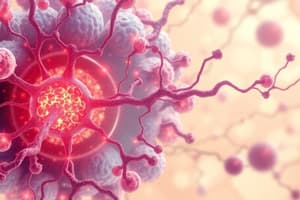Podcast
Questions and Answers
Which type of ion channel opens in response to changes in membrane potential?
Which type of ion channel opens in response to changes in membrane potential?
- Voltage gated (correct)
- Ligand gated
- Physical cue
- Sodium leak
Nicotinic acetylcholine receptors are an example of metabotropic receptors.
Nicotinic acetylcholine receptors are an example of metabotropic receptors.
False (B)
What is the primary role of ion channels in cells?
What is the primary role of ion channels in cells?
To allow the flow of ions across the plasma membrane.
_____ gated ion channels require the binding of a specific protein to open or close.
_____ gated ion channels require the binding of a specific protein to open or close.
Match the following ion channels with their descriptions:
Match the following ion channels with their descriptions:
What type of receptors are primarily located within the nucleus?
What type of receptors are primarily located within the nucleus?
Agonists and antagonists bind to the same receptor with the same effect.
Agonists and antagonists bind to the same receptor with the same effect.
What is the main difference between androgenic and anabolic effects?
What is the main difference between androgenic and anabolic effects?
Selective Estrogen Receptor Modulators (SERMs) have _______ effects in breast tissue.
Selective Estrogen Receptor Modulators (SERMs) have _______ effects in breast tissue.
Match the following drugs with their primary function:
Match the following drugs with their primary function:
Flashcards are hidden until you start studying
Study Notes
Pharmacodynamics
- Examines biochemical and physiological drug effects on cells and organs.
- Key concepts include receptors (macromolecules producing biological effects) and ligands (substances that bind to receptors).
Terminology
- Agonist: Activates biological effect upon binding to a receptor.
- Antagonist: Binds to a receptor but does not activate it, blocking biological effects.
- Agonist and antagonist binding concurrently leads to diminished biological effects.
Nuclear Receptor Ligands
- Small molecular weight and highly lipophilic; required to penetrate cell membranes.
Nuclear Receptor Structure (NRS)
- Composed of four functional domains:
- N-terminus (AF-1): Variable activation function region.
- DNA Binding Domain (DBD): Contains zinc finger motif for DNA interaction, conserved structure.
- Hinge: Connects domains and possesses nuclear localization signal.
- C-terminus (LBD): Ligand binding site where ligands attach, facilitates dimerization.
Mechanism of Action
- Dimerization: Following ligand binding, receptors dimerize and translocate to the nucleus, interacting with hormone response elements (HRE).
Types of Nuclear Receptors
- Type 1 (Cytosolic): Located in the cytoplasm (e.g., steroid receptors).
- Type 2 (Nuclear): Found within the nucleus, directly associated with DNA (e.g., retinoid X receptor).
Selective Receptor Modulators (SRMs)
- Exhibit tissue-selective effects: agonist in some tissues, antagonist in others.
- Include SERMs, SPRMs, and SARMs; notable SERMs are available in the USA.
Sex Hormone Receptors
- Testosterone produced in the testes and ovaries; mediates effects through androgen receptors via Type 1 signaling.
- Conversion to dihydrotestosterone (DHT) occurs via 5-alpha-reductase enzyme.
SERMs
- Designed for tissue-specific estrogen receptor modulation.
- Display estrogenic effects on bone and liver, with anti-estrogenic effects in breast tissue.
Pharmacological Actions of SERMs
- Tamoxifen: Used for breast cancer treatment; acts as an antagonist in breast tissue and agonist in others.
- Raloxifene: Prevents osteoporosis; exhibits similar effects on estrogen receptors as Tamoxifen with additional antagonism in peripheral tissues.
- Clomiphene Citrate: Fertility treatment; modifies feedback mechanisms to stimulate FSH and LH secretion.
Selective Androgen Receptor Modulators (SARMs)
- Designed for high specificity to androgen receptors, promoting anabolic effects over androgenic.
- Act on Class 1 nuclear receptors and exhibit diverse tissue responses.
Ion Channels
- Proteins forming pores in cell membranes, allowing ion movement.
- Major classes: Ligand-gated, Voltage-gated, and physically activated channels.
Ligand-Gated Ion Channels
- Key role in neurotransmission; examples include ionotropic glutamate and nicotinic acetylcholine receptors.
Voltage-Gated Ion Channels
- Composed of a diverse protein superfamily; open in response to membrane potential changes.
- Primary function in action potential generation in neurons.
Post-Synaptic Potentials
- Comprised of excitatory (EPSP) and inhibitory (IPSP) potentials; determine neuronal firing.
Ion Channel Modulators
- Targeted for conditions like addiction and blood pressure regulation; examples include calcium channel blockers for heart diseases.
- Modulators affect ion flows, altering neuronal excitability and physiological outcomes.
Insulin Secretion Physiology
- Includes inhibitors affecting bonding interactions in channels; ATP interactions play a critical role in channel regulation.
Gefitinib
- Type 1 covalent kinase inhibitor used in non-small cell lung cancer (NSCLC) treatment, targeting EGFR mutations.
Assay in Kinase Drug Discovery
- Various assays exist to investigate drug binding affinity, enzymatic function, and biological effects, critical for evaluating kinase inhibitors’ efficacy.
General Kinase Inhibitor Properties
- Small molecule kinase inhibitors are typically lipophilic and metabolized by cytochrome P450 enzymes, often dosed orally for patient convenience.
Studying That Suits You
Use AI to generate personalized quizzes and flashcards to suit your learning preferences.




